This article’s introduction is longer than normal. Click here to skip ahead, or here to skip to the app I built for this post.
Since the October 7th Hamas terrorist attacks that left over 1000 Israelis dead (~695 of them civilians), over 21,600 Palestinians have been killed by IDF forces. Although the Israeli government claims it has focused its efforts on rooting out Hamas, their forces have killed over 8,800 children and 6,300 women.
Importantly, the U.S. has provided tremendous funding towards Israel’s war effort. I actually wrote about this previously — from 2008 to 2021, the US has sent over $48 billion in aid to Israel, most of it military in nature. Many Americans feel that their government’s funding of such a lopsided conflict is irresponsible and unethical. After all, Israeli citizens enjoy things like free healthcare and affordable college tuition. On the other hand, the average American pays $8,435/year for healthcare and $156k to $223k for a college degree.
Throughout all this, President Biden and his administration have reiterated their unwavering support for Israel. The Biden Administration has repeatedly lobbied for increased unconditional military aid to Israel since October 7th. In fact, it has gone as far as to use unilateral executive action to send munitions to Israel, bypassing the standard 20-day congressional committee review for such actions. Overall, Biden has requested $14.3 billion in additional military aid to Israel. The U.S. has also used its veto power to block U.N. resolutions calling for a humanitarian ceasefire. Furthermore, President Biden has repeatedly reiterated debunked Israeli propaganda. No matter how you slice it, President Biden has made it clear what side of the conflict he stands on: he has prioritized military aid to Israel over humanitarian aid and assistance to Gaza.
In response, Arab and Muslim Americans have felt uniquely betrayed by their president. This demographic broke in large numbers for Biden in 2020, with some exit polls estimating that nearly 80% of Arab Americans voted for him. However, given Biden’s unequivocal support for Israel and relative silence on Palestinian death and anguish, Arab and Muslim American support for President Biden has cratered in the last few months. In fact, a recent poll by the Arab American institute showed that only 17.4% of respondents would vote for Joe Biden in 2024.
Of course, the GOP is no friend to Muslim Americans either. Ultimately, the choice faced by Arab & Muslim Americans is complicated and not easy. I won’t spend much time talking about it in this post, but this NPR article is an excellent piece on how this demographic is currently thinking.
This collapse in support is particularly problematic for President Biden given the electoral math he faces in 2024. Although he handily beat Trump in the popular vote in 2020, Biden won a few key swing states by razor-thin margins. And unfortunately for Biden, many of these swing states – like Michigan and Arizona – contain large populations of Arabs and Muslims.
Okay, so that was a longer introduction that usual. This is Stats with Sasa, so let’s run some numbers. In particular, let’s consider whether collapsing support for Biden among Arab and Muslim Americans will flip key swing states. More concisely:
Will Biden’s unequivocal support for Israel cost him the 2024 Election?
Click below to skip ahead:
- What will cause swing states to flip?
- How much support can Biden afford to lose in each state?
- A simpler look
- What recent poll numbers suggest will happen
- See for yourself
- I created an Interactive App that allows you to play with scenarios for yourself! You can download and share your results with your friends.
- Conclusion
- Methodology
What’s needed to flip swing states?
For this article, I pulled demographic data on Arab and Muslim populations by state. I then used exit polls and turnout statistics to estimate how many Arab and Muslims voted for Biden and Trump in 2020. For more information on the methodology underpinning this analysis, click here. This analysis presumes Trump will be the 2024 GOP nominee, which is arguably conservative considering the considerable baggage he has for Arab/Muslim voters.
Given the information collected, we can calculate how much support Biden can afford to lose before key swing states flip from Democrat to the GOP. Of course, change in vote share is not the only component of this analysis. Many Arabs and Muslims may simply choose to stay home and not vote at all given their two disappointing choices. As a result, this analysis has two dimensions: change in vote share for Biden and change in turnout.
For the rest of this post, I consider two scenarios: a conservative scenario that only considers Muslim voters, and a loosened scenario that considers both Arab and Muslim voters. The following charts show the results of an analysis of which vote share and turnout changes will cause swing states to flip. Note that the axes on these charts consider percentage point changes. So, a 20% change in vote share/turnout indicates that vote share/turnout went from, say, 50% to 70%.
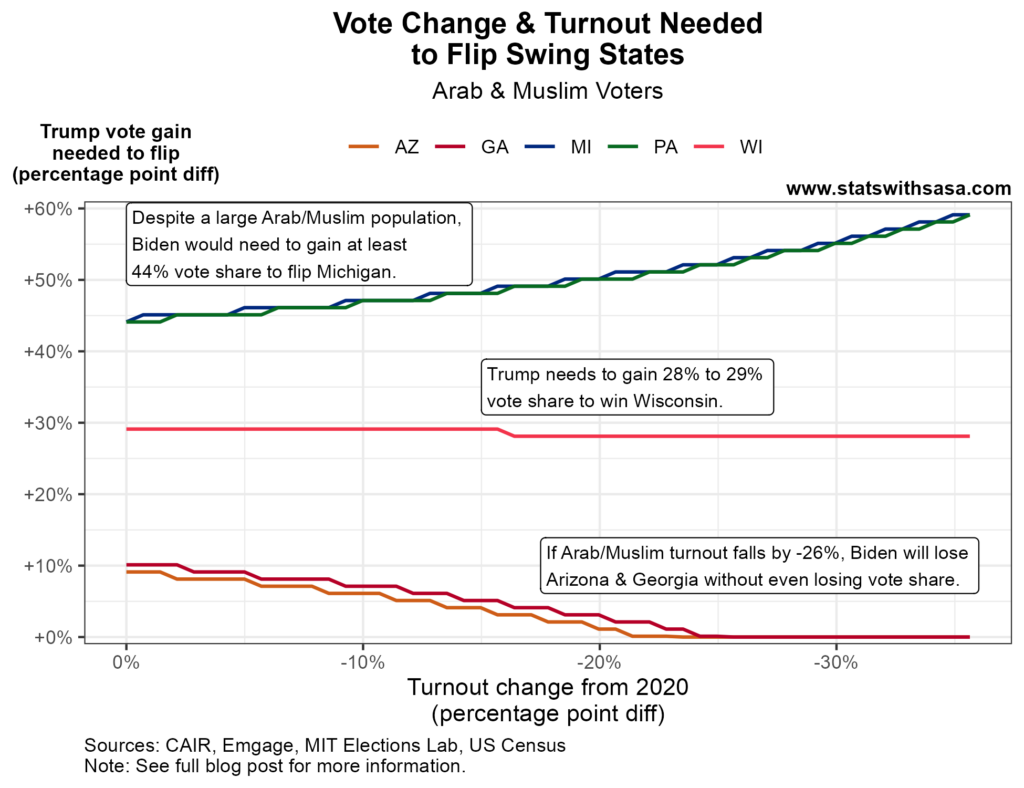
Here’s how to read this chart: the lines tell us which vote share and turnout change combination will result in a specific swing state flipping from Biden to Trump. For instance, if Arab & Muslim turnout falls by 20 percentage points and Trump gains 28 percentage points of vote share at Biden’s expense, Wisconsin will flip to the GOP in 2024.
The loosened scenario tells us several interesting things. First, if turnout among Arabs & Muslims falls by just 26 percentage points or more, Biden will lose Georgia and Arizona without losing any vote share. Second, the vote share change needed for Biden to lose Wisconsin is robust to change in turnout: Biden losing 28-29 percentage points in vote share among Arab & Muslim Americans will flip Wisconsin. Finally, despite a notoriously large Arab/Muslim population in Michigan, Biden would still need to lose at least 44% vote share to lose Michigan.
Now let’s consider the conservative scenario:
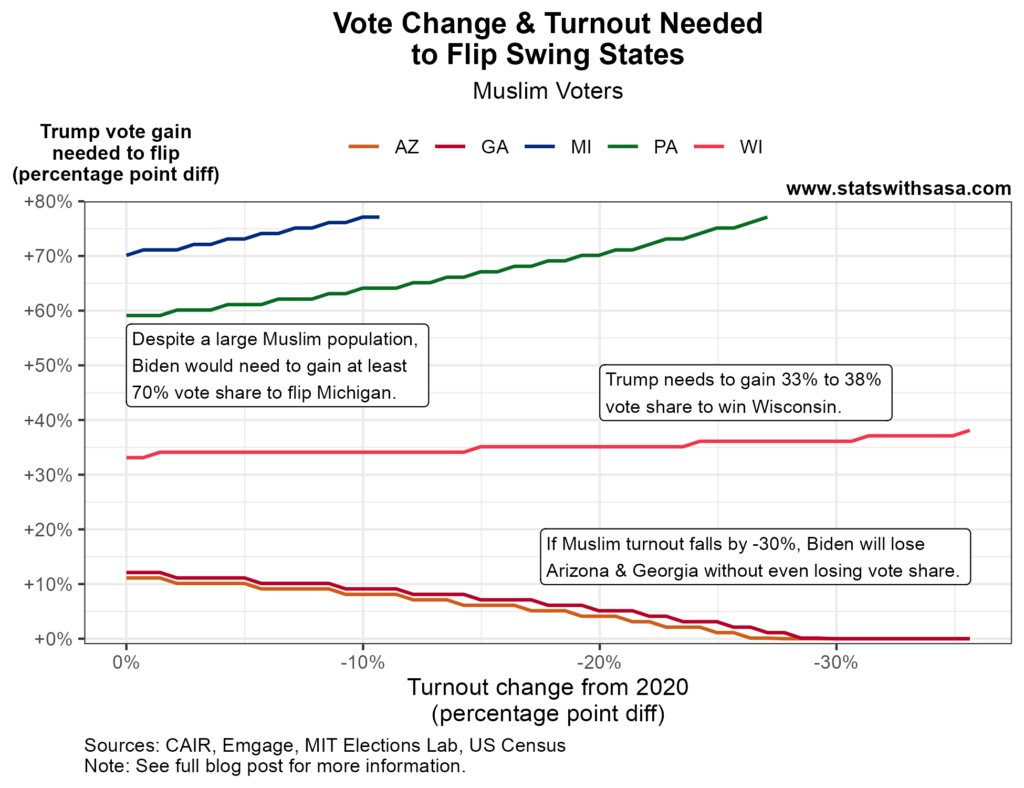
The conservative scenario shows somewhat similar results. Georgia & Arizona will flip with only a ~30 percentage point turnout dip. Biden losing 33 to 38 percentage points vote share to Trump will flip Wisconsin. No matter how turnout changes, it would take something monumental to flip Michigan or Pennsylvania.
A simpler look
Admittedly, the chart above is not incredibly intuitive. So, to make things simpler, let’s just consider what the most recent poll numbers suggest will happen. A recent poll by the Arab American Institute indicated that 17.4% of respondents would vote for Biden, compared to 40% for Trump. Meanwhile, 17.5% indicated they would vote third-party, and 25.1% were unsure. If we adjust these numbers to eliminate the unsure respondents, this most recent poll suggests that 22.6% of Arab/Muslim Americans will vote for Biden in 2024, while 53.4% will vote for Trump.
Such a drastic change in support for a candidate would be astonishing, but in line with general trends. In 2016, Democrats outnumbered Republicans 2 to 1 among Arab Americans. However, in this most recent poll, just 23% of Arab Americans identified as Democrat, compared to 32% identifying as Republican.
The following charts summarize how key swing states will fare according to these new poll numbers, as well as how the overall Electoral College will be affected. We assume that turnout will not change. Note that the 2020 Census resulted in a redistribution of electoral votes. These charts take this into account in a hypothetical 2024 election. For simplicity, I also assume that the split electoral votes in Maine and Nebraska remain unchanged.
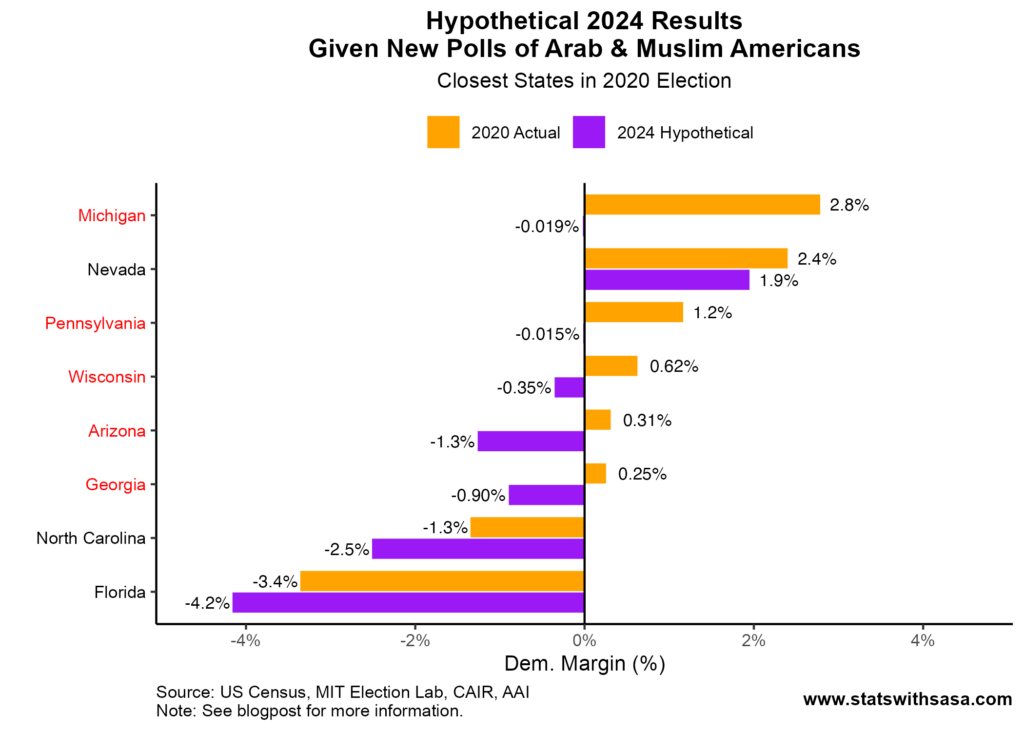
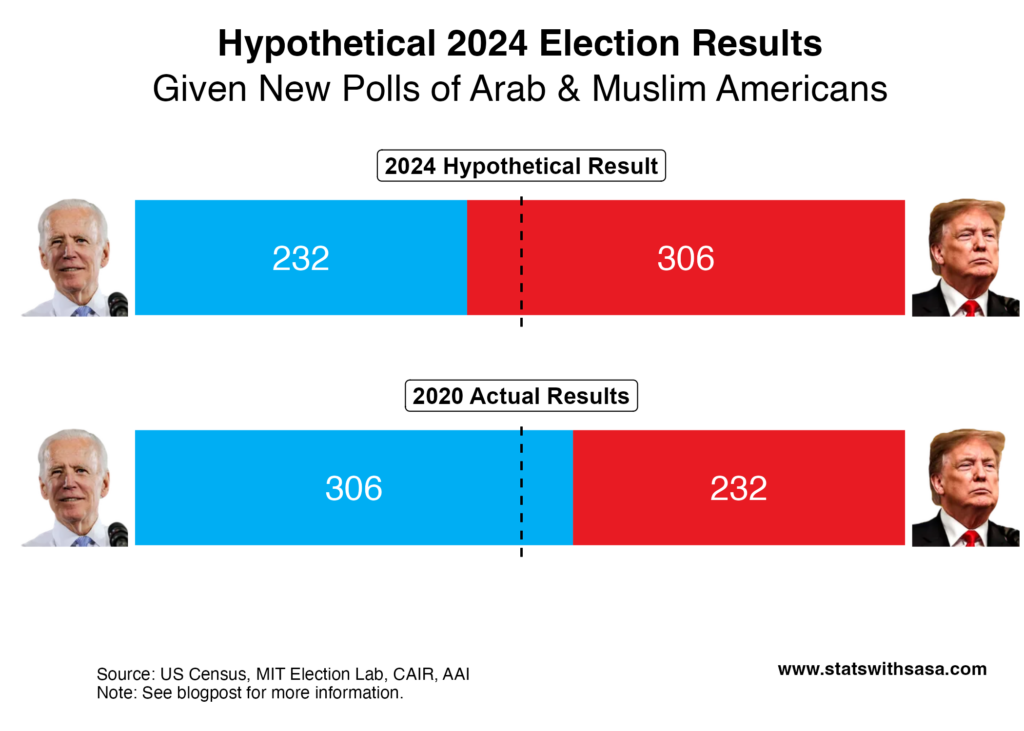
If we use our loosened scenario that considers both Arab and Muslim Americans, the recent poll numbers yield stark conclusions. Biden will lose Michigan, Pennsylvania, Wisconsin, Arizona, and Georgia. Doing so will completely flip the results from 2020, giving Trump a landslide electoral victory. That being said, Biden will still win the popular vote — by 2.9%, rather than the 4.4% he won by in 2020.
Now let’s consider our conservative scenario to see if these results hold:

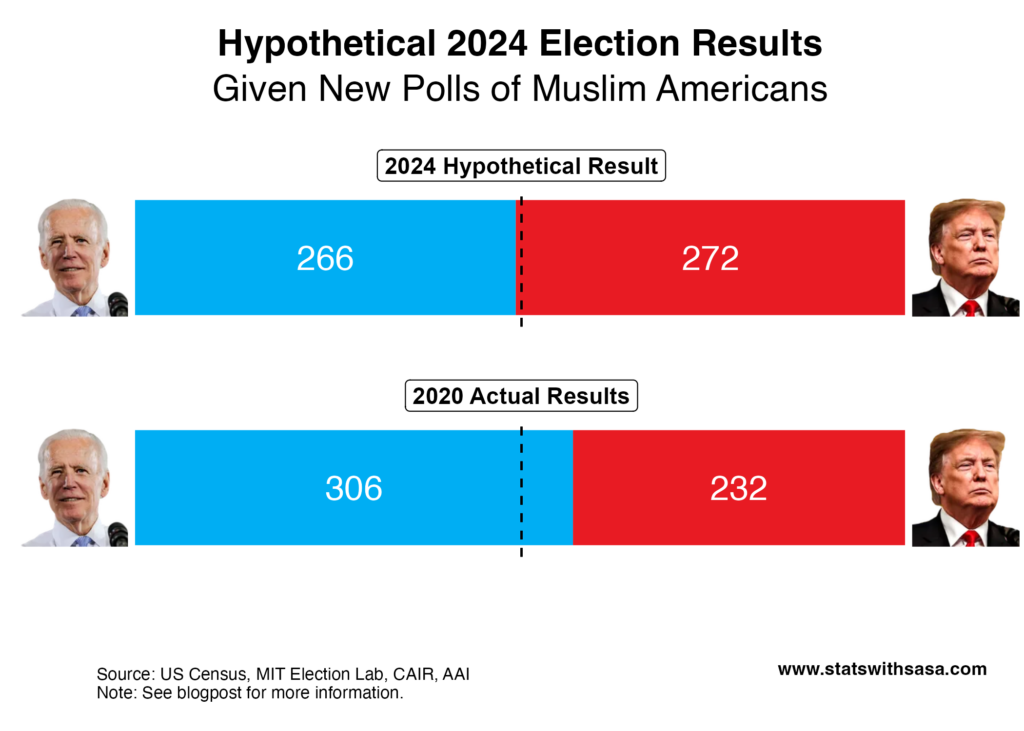
In the conservative scenario, Biden still loses Wisconsin, Arizona, and Georgia. Since the Electoral Vote redistribution favors Republicans, this will give Trump a narrow victory in 2024. Again, Biden still wins the popular vote — by 3.3% this time.
See for yourself
Do you have a different opinion of how Arab/Muslim vote will change in 2024? Or do you just want to play around with the numbers to check out different scenarios? Luckily for you I have designed an App that will allow you to enter in your own guesses for Arab and/or Muslim American votes in a hypothetical 2024 election. You can even download the results and share them with your friends if you want!
Check out the app here!
Conclusions
My analysis suggests that Biden’s actions in the wake of the intensified Israel/Palestine conflict have been a miscalculation. By prioritizing military aid to Israel over humanitarian aid to Gaza, Biden has lost most of his credibility among an Arab and Muslim population that overwhelmingly supported him in 2020. Unfortunately for Biden, there are a lot of Arabs and Muslims in swing states. There are over 150,000 Muslim voters in Michigan alone. Biden won the state by just 154,188 votes. And remember that the way that election math works means that 75,000 voters switching from Biden to Trump is effectively a 150,000 vote swing (subtract Biden’s total by 75,000, then add 75,000 to Trump’s total).
Biden always had a tough path to re-election ahead of him. Despite a convincing popular vote victory in 2020, his electoral victory hinged on razor-thin margins in key states. For example, Biden won Wisconsin, Arizona, and Georgia by less than 1 percentage point. Losing these states in 2024 would hand the GOP the presidency. And it looks like Arab and Muslim Americans could be that difference in these states.
Thanks for reading this far. As my friends can attest, I’ve been working on this article for a long time. Any dedicated readers of my blog can probably also now figure out that this conflict is something that I’ve been paying close attention to. As a kind of disclaimer, my father and his family are Indian Muslims, and I grew up in a post-9/11 America where I faced a good deal of bigotry due to my skin color and name. The heightened tensions that have arisen recently have left me with some familiar echoes.
I mean, a Palestinian student from my Alma Mater was recently shot in a hate crime and has now been left paraplegic. And in response, the University arrested and pressed charges against students who protested for divestment afterwards. I should suppose that is not entirely out of line for Brown, though — the University was quick to place students on probation for protesting Apartheid South Africa. For all his (many) flaws, President Bush clearly and emphatically stated in the early days after 9/11 that Muslims living in America were not the enemy. In comparison, President Biden has been eerily silent as Muslims around the country face heightened harassment and violence. And people have noticed.
Anyway, I digress. Sometimes I like to end my pieces with some music. Given the topic, I’d like to share one of my favorite songs by Riz Ahmed (yes, the actor). Don’t forget to subscribe if you want to read more stuff like this.
Methodology
For this post, I pulled demographic data on Arab and Muslim Americans for each state. Furthermore, I used a statistic by the Arab American Institute that showed ~1/3 of Arab Americans are Muslim to estimate the joint Arab and Muslim American population (so as not to double count Arab Muslims). Finally, I used demographic and citizenship statistics to estimate the voting population of Arab and Muslim Americans in each state.
Subsequently, I used an Emgage Report that estimated Muslim American turnout in 2020. Importantly, I assumed that Arab and Muslim Americans had similar voting patterns in 2020. Finally, I used a CAIR Exit Poll to estimate how these demographics voted for Biden vs. Trump in 2020.
Combining these data sources gave me enough information to estimate how many Arabs & Muslims voted for Biden and Trump in 2020, and subsequently estimate the impact of changes in voting patterns for these groups.
